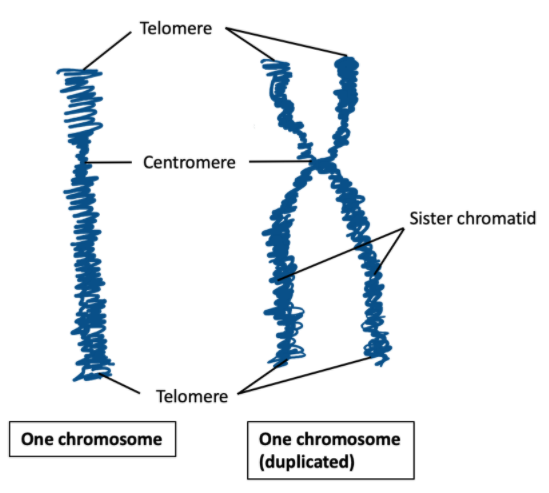
If there are 20 chromatids in a cell, how many centromeres are there?
Answer
512.7k+ views
Hint: A chromatid is one of two identical halves of a replicated chromosome and the centromere is the specialized DNA sequence of a chromosome that links a pair of sister chromatids. During mitosis, spindle fibres attach to the centromere via the kinetochore.
Complete answer:
Before partition sister chromatids stay connected at centromeres. After division, every chromatid turns into a daughter chromosome. The cell is as yet partitioned and not isolated in two daughter cells by cytokinesis. On the off chance that there are 20 centromeres found in anaphase, there are 20 chromosomes in the partitioning cell. Consequently, each shaft of the partitioning cell will get 10 chromatids: every chromatid will presently turn into a chromosome for the daughter cell.
Centromeres are the attachment points for two replicated sister chromatids and appear only when DNA replication occurs. That is, the normal number of chromosomes in the cell is 10, and there are normally 5 chromosome pairs. Now that there are 20 chromatids, they should be in identical pairs of two (sister chromatids) because replication has occurred.

So, there would be 10 centromeres.
Note: A chromosome contains 2 chromatids and a centromere. DNA (deoxyribonucleic Acid) is the hereditary material of living beings present in the chromosome. In people, DNA is found in practically every. At the point when a cell in the body separates, it will give a duplicate of its DNA to every one of its daughter cells.
Complete answer:
Before partition sister chromatids stay connected at centromeres. After division, every chromatid turns into a daughter chromosome. The cell is as yet partitioned and not isolated in two daughter cells by cytokinesis. On the off chance that there are 20 centromeres found in anaphase, there are 20 chromosomes in the partitioning cell. Consequently, each shaft of the partitioning cell will get 10 chromatids: every chromatid will presently turn into a chromosome for the daughter cell.
Centromeres are the attachment points for two replicated sister chromatids and appear only when DNA replication occurs. That is, the normal number of chromosomes in the cell is 10, and there are normally 5 chromosome pairs. Now that there are 20 chromatids, they should be in identical pairs of two (sister chromatids) because replication has occurred.

So, there would be 10 centromeres.
Note: A chromosome contains 2 chromatids and a centromere. DNA (deoxyribonucleic Acid) is the hereditary material of living beings present in the chromosome. In people, DNA is found in practically every. At the point when a cell in the body separates, it will give a duplicate of its DNA to every one of its daughter cells.
Recently Updated Pages
Master Class 12 Business Studies: Engaging Questions & Answers for Success

Master Class 12 Economics: Engaging Questions & Answers for Success

Master Class 12 English: Engaging Questions & Answers for Success

Master Class 12 Maths: Engaging Questions & Answers for Success

Master Class 12 Social Science: Engaging Questions & Answers for Success

Master Class 12 Chemistry: Engaging Questions & Answers for Success

Trending doubts
What is meant by exothermic and endothermic reactions class 11 chemistry CBSE

Which animal has three hearts class 11 biology CBSE

10 examples of friction in our daily life

One Metric ton is equal to kg A 10000 B 1000 C 100 class 11 physics CBSE

1 Quintal is equal to a 110 kg b 10 kg c 100kg d 1000 class 11 physics CBSE

Difference Between Prokaryotic Cells and Eukaryotic Cells




